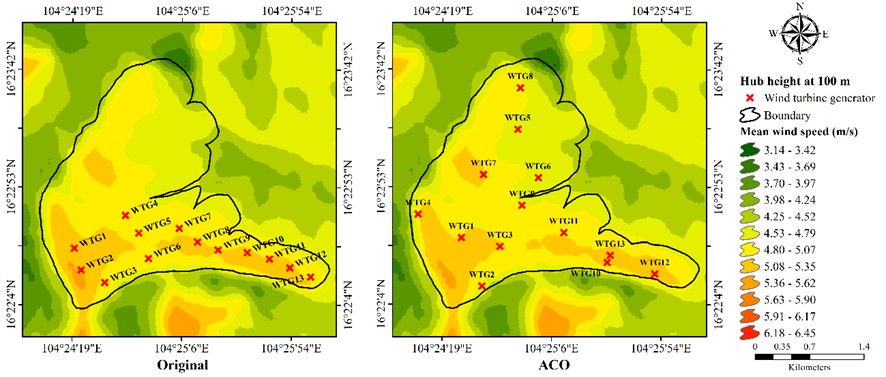Optimal Wind Power Plant Layout Using Ant Colony Optimization -
Main Article Content
Abstract
The optimal layout of wind power plants is very important as the arrangement of wind turbine generators (WTGs) profoundly affects the overall energy output of the wind power plant. To address this important issue, this research investigates the best layout for WTGs in wind power plants with different terrain features across three locations in Thailand using the Ant Colony Optimization (ACO) algorithm. The objective functions of maximizing the net annual energy production (AEP) and minimizing the wake losses were used to achieve the optimal wind power plant layout. Using the MERRA-2 database, computational fluid dynamics (CFD) wind flow modeling was performed to create 10x10 km2 microscale wind resource maps of locations characterized by flat, semi-complex, and complex terrains to install wind power plants. The CFD wind flow modeling yielded wind speeds of 5.00 to 5.76, 4.21 to 8.90, and 3.10 to 4.45 m/s for the flat, semi-complex, and complex terrains, respectively, making them feasible for utility-scale wind power plants. WTGs of multiple blade diameters, ranging from 90 to 126 m, with a nominal capacity of 2.5 MW at 100 m above ground-level hub heights, were used in this study. The Gamesa G126-2.5MW WTG with a 126 m blade diameter produces the highest net AEP of 14.3, 76.1, and 38.9 GWh/yr for the three terrains. Hence, this WTG was used to perform an ACO-based optimization to improve the electricity production of the wind power plants. Such studies are important to improve the efficiency of wind power plants, thus extracting the maximum kinetic energy possible from the winds and improving the economic viability of wind power plants.
Article Details

This work is licensed under a Creative Commons Attribution-NonCommercial-NoDerivatives 4.0 International License.
References
GWEC, Global Wind Energy Council, Global wind report 2022, Wind Energy Technol. 2022. 75. https://gwec.net/global-wind-report-2022/.
EGAT, EGAT Report. 2018. https://www.egat.co.th/en/images/publication/EGAT-Overview-2018_en.pdf (accessed June 8, 2023)
Department of Alternative Energy Development and Efficiency. Percentage of Alternative Energy Consumption. 2023a. Retrieved from https://www.dede.go.th/download/state_66/Percentage_of_Alternative_Energy_Consumption_November_2565.pdf (accessed: 20.12.2023)
Department of Alternative Energy Development and Efficiency. The Alternative Energy Development Plan 2018-2037 (AEDP2018). 2023b. Retrieved from https://www.dede.go.th/download/Plan_62/20201021_TIEB_AEDP2018.pdf (accessed: 20.12.2023)
Puangkaew, W.; Waewsak, J.; Kongruang, C.; Chancham, C.; Matan, N.; Tirawanichakul, Y.; Tirawanichakul, S. Assessment of Wind Energy Resource and Feasibility of Installing 0.225-0.75 MW Wind Power Plants along the Coast of Nakhon Si Thammarat and Songkhla Provinces. Thaksin University Journal. 2010, 12, 129–137.
Chiwamongkhonkarn, S.; Waewsak, J.; Chaichana, T. Wind Resource Potential at Pak Phanang and Chian Yai Districts of Nakhon Si Thammarat Province. Thaksin University Journal. 2014, 17, 13–20.
Chiwamongkhonkarn, S.; Waewsak, J.; Chancham, C. Forecasting of Wind Speed Using Advanced Research-WRF Model. Thaksin University Journal. 2020, 23, 20–30.
Ranthodsang, M.; Waewsak, J.; Kongruang, C.; Gagnon, Y. Offshore wind power assessment on the western coast of Thailand. Energy Reports. 2020, 6, 1135–1146. https://doi.org/10.1016/j.egyr.2020.04.036.
Waewsak, J.; Niyomtham, L.; Cheewamongkholkarn, S.; Chancham, C. Offshore Wind Resource Assessment of Thailand Using Remote Sensing Technique. ASEAN Journal of Scientific and Technological Reports, 2021, 24(1), 71–83. https://doi.org/10.55164/ajstr.v24i1.226833
Chancham, C., Waewsak, J., Gagnon, Y., Offshore wind resource assessment and wind power plant optimization in the Gulf of Thailand, Energy. 2017, 139, 706–731. https://doi.org/10.1016/j.energy.2017.08.026
Waewsak, J., Chancham, C., Chiwamongkhonkarn, S., Gagnon, Y., Wind Resource Assessment of the Southernmost Region of Thailand Using Atmospheric and Computational Fluid Dynamics Wind Flow Modeling. Energies. 2019, 12(10), 1899. https://doi.org/10.3390/EN12101899
Waewsak, J.; Landry, M.; Gagnon, Y. High-resolution wind atlas for Nakhon Si Thammarat and Songkhla provinces, Thailand, Renew. Energy. 2013, 53, 101–110. https://doi.org/10.1016/j.renene.2012.11.009
An Industry Perspective on Strengthening Onshore Wind Development in Thailand. https://ec.europa.eu/eurostat/statistics .(accessed April 29, 2023)
Leung D.Y.C.; Yang, Y. Wind energy development and its environmental impact : A review, Renew. Sustain. Energy Rev. 2012, 16. 1031–1039. https://doi.org/10.1016/j.rser.2011.09.024
Molnarova, K.; Sklenicka, P.; Stiborek, J.; Svobodova, K.; Salek, M.; Brabec, E. Visual preferences for wind turbines : Location, numbers and respondent characteristics, Appl. Energy. 2012, 92, 269–278. https://doi.org/10.1016/j.apenergy.2011.11.001
Yang, K.; Kwak, G.; Cho, K.; Huh, J. Wind farm layout optimization for wake effect uniformity. Energy. 2019, 183, 983–995. https://doi.org/10.1016/j.energy.2019.07.019
Chen, K.; Song, M.X.; Zhang, X.; Wang, S.F. Wind turbine layout optimization with multiple hub height wind turbines using a greedy algorithm, Renew. Energy. 2016, 96, 676–686. https://doi.org/10.1016/j.renene.2016.05.018
Nagpal, S.V.; Liu, M.V.; Anderson, C.L. A comparison of deterministic refinement techniques for wind farm layout optimization, Renew. Energy. 2021, 168, 581–592. https://doi.org/10.1016/j.renene.2020.12.043
Eroĝlu, Y.; Seçkiner, S.U. Design of wind farm layout using ant colony algorithm, Renew. Energy. 2012, 44, 53–62. https://doi.org/10.1016/j.renene.2011.12.013
Yunus, E. Wind farm layout optimization using ant colony and particle filtering approaches Wind Farm Layout Optimization using Ant Colony and Particle Filtering Approaches in Industrial Engineering Publication (https://doi.org/10.13140/RG.2.2.11304.26883) [Master Thesis University of Gaziantep]. 2017.
Werapun, W.; Tirawanichakul, Y.; Waewsak, J. Wind Shear Coefficients and their Effect on Energy Production. Energy Procedia. 2017, 138, 1061–1066. https://doi.org/10.1016/J.EGYPRO.2017.10.111
Islam, K.D.; Theppaya, T.;Ali, F.; Waewsak, J.; Suepa, T.; Taweekun, J.; Titseesang, T.; Techato, K. Wind energy analysis in the coastal region of bangladesh. Energies. 2021, 14, 1–18. https://doi.org/10.3390/en14185628
WindSim-CFD wind flow modeling www.windsim.com (Accessed on 28 November 2022)
Waewsak, J.; Kongruang, C.; & Gagnon, Y.; Assessment of wind power plants with limited wind resources in developing countries: Application to Ko Yai in southern Thailand. Sustainable Energy Technologies and Assessments. 2017, 19, 79-93.


